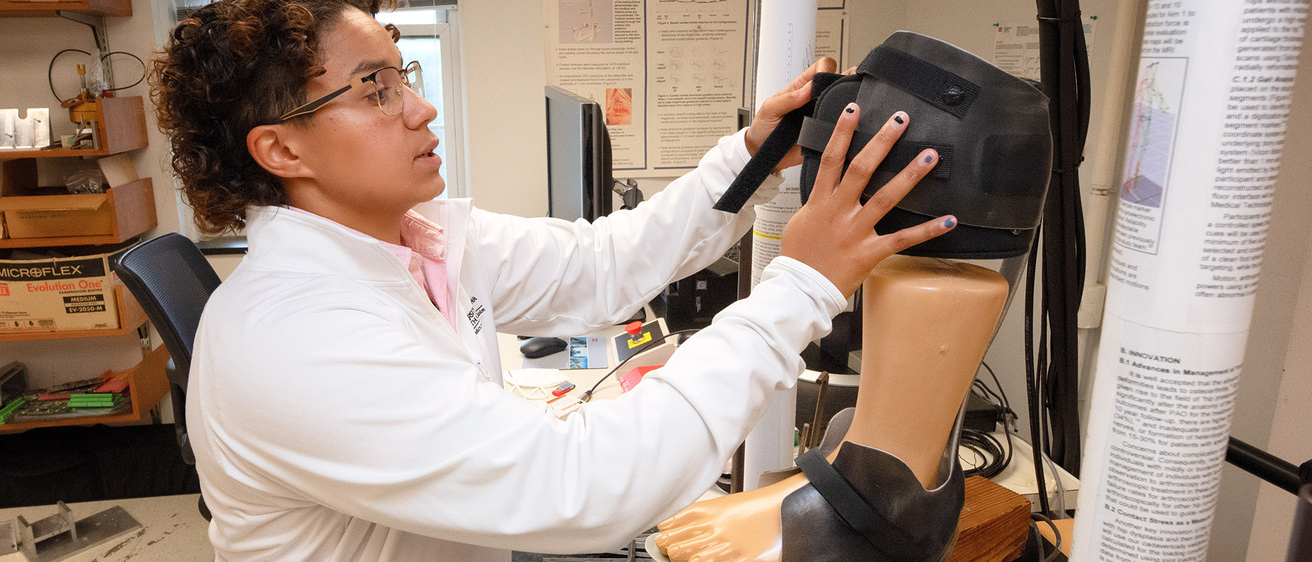Biomedical engineering isn’t just one job. It’s a diverse field with many specializations.
Whether you’re interested in research, design, or systems integration, a biomedical engineering degree offers endless opportunities to make an impact on health care and patient outcomes.
Are there different types of biomedical engineering?
Yes, there are. Biomedical engineering is a broad and interdisciplinary field that is constantly evolving alongside advances in medicine, biology, and technology. This means that there are many types of biomedical engineers, each focusing on a unique area and each employed in a very different job.
Many biomedical engineering programs include focus areas designed to enable their students to acquire in-depth knowledge in their specific area of interest. The University of Iowa, for example, offers four focus areas.
“Biomedical engineering encompasses a broad range of interests, so make sure the school has the resources to support the track that interests you,” says Kelsey Lyons, a University of Iowa biomedical engineering grad and fourth-year student at Georgetown University School of Medicine. “If you’re more inclined to computer science, make sure your program incorporates coding classes. Interested in product development? Make sure there are courses in computer-aided design or access to 3D printing.”
Along with required courses, which may include courses in engineering, math and science, and general education, biomedical engineering students also will take classes specific to their selected area of focus. For example, a student at the University of Iowa who is interested in biomedical imaging may take courses in medical imaging physics, digital image processing, and introduction to software design.
“Most biomedical engineering programs will have you take a broad array of courses. For example, foundational math and physics courses, introductory electrical engineering, computer engineering, and mechanical engineering courses,” says Kim “Avrama” Blackwell, professor and departmental executive officer of biomedical engineering at the University of Iowa. “You typically don’t have to choose your subfield until your junior year, so you get to do a lot of exploration within biomedical engineering.”
What are 8 types of biomedical engineering?
There are more than eight types of biomedical engineering — many more. Which is great because all these options give you the flexibility to align your education with your passions and professional goals.
To get you started, here are eight of the more common types of biomedical engineering you may want to pursue.
Bioinformatics and computational bioengineering
A staggering amount of data exists in today’s world, including in medicine. For example, databases of gene sequences can contain many millions of entries. Bioinformatics and computational bioengineering combine skills and technologies from computer science, mathematics, statistics, biology, and engineering to manage, analyze, and use these complex datasets to improve human health.
While the fields are similar and have some overlap, bioinformatics and computational bioengineering are distinct disciplines. Bioinformatics primarily focuses on data management and analysis, giving meaning to the data. Computational bioengineering, on the other hand, tends to address theoretical and experimental questions in biology through simulation and modeling.
Students who study these types of biomedical engineering may pursue careers in biomedical software engineering, biomolecular engineering, biotechnology, cell-based therapy development, gene therapies, genetic engineering, computational drug design, machine learning, or health informatics.
Bioinstrumentation
Engineers focused on bioinstrumentation use principles from engineering, computer science, and electronics to develop devices that are used in the research, diagnosis, monitoring, and treatment of medical problems.
Examples may include:
- Imaging devices such as MRI, ultrasound, and X-ray machines.
- Diagnostic and therapeutic tools such as insulin pumps, blood analyzers, and hearing aids.
- Monitoring devices such as ECG, EEG, blood pressure monitors, and pulse oximeters.
- Surgical instruments such as endoscopic devices and robotic surgical systems.
Biomaterials
Biomaterials engineers design, develop, and test materials that are used in medical devices or must function in the body. These materials may be natural or synthetic and can include living cells, tissue, metals, ceramics, polymers, glasses, carbons, and composite materials.
The study of biomaterials combines knowledge from fields such as biology, chemistry, and engineering.
Biomaterials can be used in a variety of applications, such as:
- Implants, including artificial joints, ligaments, and tendons; heart valves, stents, grafts; contact lenses; or dental and hearing loss implants.
- Sutures, staples, and dissolvable dressings for wound closure.
- Molecular probes and nanoparticles that aid in cancer imaging and treatment.
- Biosensors, such as blood glucose monitoring devices, that detect the presence and amount of specific substances.
Biomechanics
Biomechanical engineering is primarily about understanding how the body moves, from the inner workings of a cell to a person going for a run.
Biomechanical engineers combine knowledge in mechanical engineering and biology to aid in the design and development of products, equipment, and techniques for use in the medical field and beyond.
Engineers working in biomechanics may study, among other things:
- Mechanical properties of the body, including the inner workings of cells, soft tissues, and bone.
- Human movement, exploring the forces that act on the body and the effects that they produce.
- Injury and disease, and how they affect the body’s mechanics.
- Biofluidics, or the movement of fluids through the body, such as blood.
- Ergonomics, or how to design workspaces or tools to reduce strain and improve efficiency.
- Robotics and prosthetics, and how to design systems and artificial limbs to assist people with disabilities.
- Sports and exercise, analyzing how movement can improve performance and prevent injuries.
You can find biomechanical engineers working in a variety of fields, including medicine, sports science, ergonomics, physical therapy, or even space studies.
Cell and tissue engineering
Cell and tissue engineering experts study how cells behave and function to use them to repair, replace, or regenerate damaged cells, tissues, or organs.
Biomedical engineers who focus on this area work to manipulate and control cellular and subcellular processes for a range of applications, such as:
- Replacing or regenerating diseased or damaged tissues, organs, and cells.
- Creating skin substitutes.
- Destroying tumors.
- Manufacturing vaccines.
- Developing heart valves and blood vessels.
- Developing therapies for neural injuries and disorders.
- Devising strategies to repair or prevent tissue damage from aging or disease.
Cell and tissue engineers may work in areas including cancer, infectious disease, regenerative medicine, and aging.
Clinical engineering
Clinical engineers improve patient care by bridging the gap between technology and clinical practice, ensuring the safe and effective use of medical equipment and technologies.
They may be involved in:
- Testing, selecting, acquiring, and installing medical devices.
- Safety and risk management, ensuring that medical devices are used correctly and minimizing risks to patients and staff.
- Diagnosing and repairing problems associated with medical equipment.
- Training and educating health care professionals on the use of medical devices.
- Evaluating new technologies and working with manufacturers to enhance performance.
Clinical engineers may work with hospitals, medical equipment manufacturers, consulting firms, or in research and development.
Medical imaging, biomedical imaging, bioimaging
These related fields use and develop techniques that create images of the body — from the molecular, cellular, tissue, and organ levels. Information gained from medical imaging is critical to understand normal anatomy, as well as to diagnose and treat disease.
Common medical imaging devices include X-ray, ultrasound, magnetic resonance imaging (MRI), computed tomography (CT), and positron emission tomography (PET).
This field includes using artificial intelligence to automate analysis of medical images.
Biomedical engineers who work in medical imaging may collaborate with experts in fields such as biology, physics, chemistry, and electrical and mechanical engineering.
Rehabilitation engineering
Rehabilitation engineers research, design, and build devices and systems to assist people with challenges related to mobility, communication, cognition, hearing, and vision. These technologies can change lives by helping with day-to-day activities, allowing people to sustain independence and gain or maintain employment.
Examples include:
- Prosthetics, such as artificial limbs.
- Wheelchairs and scooters.
- Cochlear implants.
- Retinal implants.
- Computer interfaces that use the brain’s electrical impulses to allow a person to do things such as move a computer cursor or robotic arm, or convert text into spoken word.
- Assistive devices for everyday tasks, such as kitchen tools with large, cushioned grips to help people with weakness or arthritis in their hands.
As you can see, some activities may cross two or three types of biomedical engineering. For example, if you are interested in working with prosthetics, you may need to decide whether you want to specialize in biomechanics or rehabilitation engineering.
While these may be the most common types of biomedical engineering, others may include:
- Biomechatronics
- Biomimetics
- Bionanotechnology
- Bioprocess engineering
- Biotechnology
- Neuroengineering
- Pharmaceutical engineering
- Synthetic biology
- Systems biology
- Systems physiology

“Think about what excites you. Do you like coding? Mechanics? Biology? These interests will help guide your exploration.”
How much money does a biomedical engineer make?
Biomedical engineering is generally a well-paying field. Salaries vary based on experience, specialization, and location, but biomedical engineers often enjoy strong job prospects and competitive pay.
According to the U.S. Bureau of Labor Statistics, the median annual salary for biomedical engineers in the United States was $106,950 in 2024. This is significantly higher than the median salary for all U.S. occupations, which hovers around $49,500.
Below you’ll find salary ranges for biomedical engineers throughout the United States. The median annual salary is there, but we also want to show what an income looks like at various percentiles. The lower point gives you an idea of where entry-level jobs might land, while the upper percentile demonstrates what experience or an advanced biomedical engineering degree might help you earn.
If you are interested in numbers from other states, visit the U.S. Bureau of Labor Statistics website and select the state you’re interested in.
Cost of living also matters. A $93,000 salary in Iowa often stretches further than $127,000 in California. It would be wise to plug numbers into a cost-of-living calculator to see how far a dollar in one region might stretch (or shrink) in a different ZIP code. There are many calculator options on the web; this one from SmartAsset has a broad selection of U.S. cities available for comparison.
